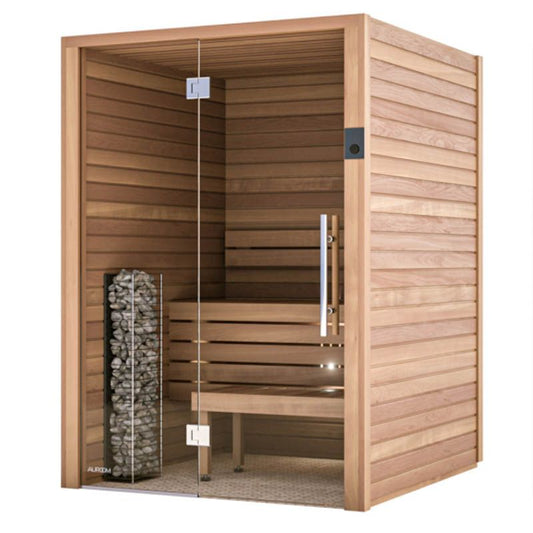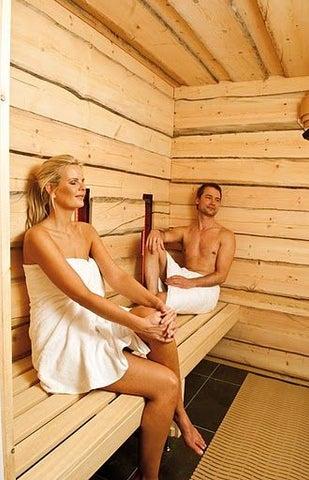Unknown Facts About Traditional Sauna
Unknown Facts About Traditional Sauna
Blog Article
The 9-Minute Rule for Traditional Sauna
Table of ContentsGetting My Traditional Sauna To WorkThe Of Traditional SaunaWhat Does Traditional Sauna Mean?About Traditional Sauna
Most of the weight lost in a sauna is water loss and is re-gained upon rehydrating. Without an uncertainty sauna can be an essential component of a healthy and balanced weight loss program. To check out the distinctions between conventional and IR saunas, I will separate these right into verifiable, theoretical, and fabricated distinctions.Therefore, the most popular factor in the saunawhich is at the ceiling directly over the sauna heateris typically between 185 and 190 F. Traditional Sauna. Claims that a conventional sauna exceeds 200 F is merely not real and not relevant for electrical saunas offered in the US. The temperature level for a far-infrared sauna is normally established between 120 and 140 F; however, unlike the typical sauna, the objective in and IR area is not to accomplish a high temperature
Because of this, the temperature difference is virtually pointless, because profuse sweating causes both sauna kinds, however the method of heating up the body is different. In an IR sauna the bather will certainly feel warm and will certainly sweat profusely, but at a lot reduced temperature levels. Thus, if the goal is to invest longer amount of times in the sauna, the IR sauna is an excellent choice.

What Does Traditional Sauna Mean?
When the heat is achieved, the elements cycle on and off to maintain the high temperature level. The majority of standard sauna customers delight in putting water over the rocks to produce vapor to elevate sauna moisture levels. The advantages of putting water over the rocks include: making the area a lot more comfortable, dampening the nasal passages, and enabling the usage of aromatherapy by mixing important oils with the water.
In a far-infrared sauna, the warm front penetrate the body to efficiently heat up the body and increase the body core temperature. To attain this raised temperature, Far-infrared emitters develop infrared power which is close to the very same wavelength as that which the body normally emitsoften referred to as the "Important Range" of 7 to 14 microns), so the energy is well gotten by the body.
When the energy goes into the body, it creates the body temperature to increase and eventually causes sweat. In an infrared sauna it is essential for the emitters/heaters to remain on practically continuously. Considering that there is no mass of rocks to check out this site preserve heat, the sauna will certainly cool down if the emitters shut down.
As mentioned over, the sauna bather in an infrared room wishes to position himself before operating emitters to get maximum gain from the warm. The home heating time for the 2 areas can be really different, relying on how the spaces are made use of. For a typical sauna, a bather ought to permit 30-40 mins for the area to accomplish a preferred temperature and to correctly pre-heat the rocks.
About Traditional Sauna
A well built sauna will commonly achieve a temperature of 150-160 F in regarding 30-40 minutes. For hotter temperatures, the room may need to warmth for a longer period.
To some, 15 minutes was "squandered" while the infrared energy heated up the wood panels instead of warming a body, while others discover a pre-heated space to be more comfortable and believe a raised beginning temperature is required to begin perspiring. The size of recommended use for each room is roughly the very same (10-15 mins per session); however, due to the reduced air temperature levels and the ability to feel the impacts of infrared heat faster than a typical sauna, it is not uncommon for a person to invest a total amount of 20-30 mins in an infrared sauna.
Traditional saunas have a tendency to be larger (thus utilize more electricity) than infrared saunas, although conventional saunas are certainly available in one and two individual dimensions too. For a two-person traditional sauna, 5x6 or 5x7 dimension is most prominent. The top bench can easily seat two or 3 individuals and is additionally enough time to rest during recommended you read the sauna session.


The average expense per kWH of electrical power in the U.S. is about $0.11, so a 4.5 kW heating unit will certainly cost about $.50 to run for one hour, if the heating system runs continuously for one hour. Typically a sauna heating unit will compete 75% of the first hour and 50% of subsequent hours on considering that the elements cycle once the set temperature is accomplished.
The Main Principles Of Traditional Sauna
A two person far-infrared space is usually literally smaller sized than a standard sauna, typically regarding 4' x 4' or smaller. The IR home heating system is typically 1.5-1.7 kW using a 120 volt 15 amp plug-in service. Considering that the space can be utilized earlier read this post here than a sauna area, we will certainly think the space is utilized for to of an hour including warm up time.
Lastly, there is a hardly ever discussed difference in the social experience between the two rooms. While our culture has lost some of the social advantage of the typical sauna experience, it can be very socially gratifying. From family members time in the sauna, to heart-felt discussions with loved ones, to sauna partiesthe typical sauna experience can bring about intimate mingling.
Most greater end infrared spaces consist of tinted light treatment, noise systems and full-glass fronts.
Report this page